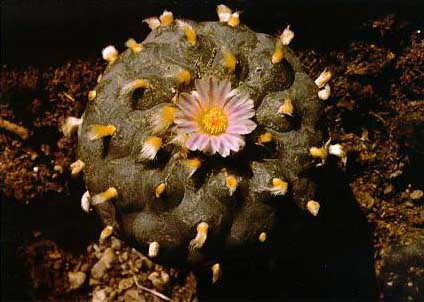Peyote (Lophophora Williamsii) is a spineless cactus with a long root. It grows in the southwesterm United States and Mexico. Its crown, or 'button', is used for psychedelic purposes. It is cut from the cactus and dried into a hard brown disc. The disc, sometimes referred to as a 'mescal button', contains a methoxylated amphetamine: mescaline (C11H17NO3) (3,4,5-trimethoxy-ß-phenethylamine). The primary natural sources of mescaline are peyote (Lophophora williamsii or Lophophora diffusa); San Pedro cactus (Trichocereus pachanoi); and Peruvian Torch (Trichocereus peruvianus)
Mescaline is one of a large group of psychedelic drugs which are structurally similar to the catecholamine neurotransmitters, dopamine and noradrenaline (norepinephrine). The addition of one or more methoxy (OCH3) groups to the carboxy ring structure confers psychedelic properties. Other methoxylated amphetamine derivatives include MDMA (ecstasy), MDA, MMDA, DOM (STP), TMA and DMA. Despite their catecholamine-like actions on the body, the psychedelic properties of these drugs at higher doses is mediated mainly by their effect on the neurotransmitter serotonin, particularly via the 5HT2a serotonin receptor.
HOME
MDMA
Mescaline
peyote.com
Arthur Heffter
San Pedro Cactus
Medline Mescaline
Psychoactive Links
Search mescaline.com
Shamanic Sacraments
The Doors Of Perception
Methoxylated Amphetamines
Mescal: A New Artificial Paradise
